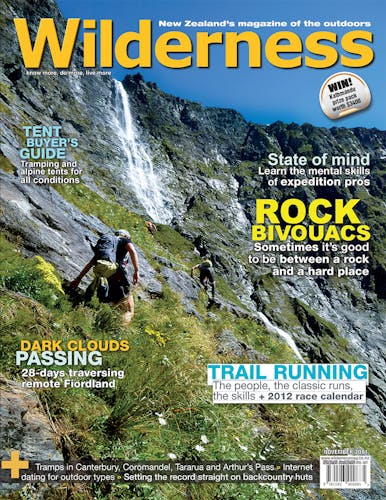History repeats but lessons learnt fall by the wayside
DOC’s Visitor Services Manager Gavin Walker repeated a few myths regarding backcountry huts in the October issue of Wilderness in the article ‘Hut network on the operating table’.
He stated that many of the old New Zealand Forest Service (NZFS) huts are ‘a product of the now defunct NZFS deer culling operation’. This simplification is misleading.
The NZFS took over deer control in 1956 and started building its first huts in 1957. By the 1958/59 season, helicopters were being used to install huts and by the mid 1960s helicopters were being used for deer control and venison recovery, largely replacing the hut-based cullers. Despite this change, the NZFS continued to build huts based around their recreation mandate. Many of the SF70 six-bunk huts – such an iconic part of the New Zealand backcountry – were built between the mid 1960s and mid 1970s. DOC Head Office has peddled the line for so long now that huts were built for deer-cullers, it seems senior staff believe their own myth.
DOC also put on the table some recreation participation goals. Sadly, when it comes to the issue of overnight experiences in backcountry huts, DOC policies continue to work against these goals.
In some places, a price-based model to control demand has worked a little too well. In August, on a perfect weather forecast, I went to Anchorage Hut on the Abel Tasman Coastal Track for a weekend. Tasman Bay was like a millpond but there wasn’t a single other person enjoying this accessible part of the park. The reason? It is very likely that DOC charging the full $32 in the winter season puts off more locals from participating.
At Mueller Hut late last November at least 40 people walked up to the hut on a perfect day. Excellent participation, until you realise only five stayed the night, which was a shame for a 28-bunk hut in season. Quite likely, many decided it was cheaper to stay the night down in the village backpackers.
These are counter productive policies for what are entry level paths to enjoying the back-country. Yet DOC is actively trying to put more huts into the booking system, moving further towards managing key assets for the comfortably well off.
It is likely that Gavin Walker and I have similar goals in terms of encouraging participation in the backcountry. I too want to see more people experiencing a night in the hills. I suspect we differ on what the real barriers are. DOC would argue that it is people’s time and the location (of huts) and not price that is the major barrier to participation. I would reply: go check out the facts on New Zealand’s average wage.
There are many good reasons to review how we fund huts and the public money DOC uses to subsidise the tourism industry. The current hut fee system raises basic issues of equity. New Zealanders pay taxes and GST for years to build up and maintain these huts, yet tourists pay just a little GST, and yet we all pay the same when it comes to wanting to enjoy those same huts.
The hut fee system also sets up frontline DOC staff (the wardens) as policemen, waiving a credit card machine in some instances, to enforce hut fees. It would be far more fitting for the experience in our parks if commerce (and policing) were kept out and that DOC staff were instead the best community relations investment they could be.
Walker also asserts in the October issue that ‘New Zealand is changing [and] it means the current network is not the network that we should be managing into the future’. This statement is a red-herring and dismisses the heritage value of huts. It carries with it the inane flaw that diminishes core values of recreating in wild places, in favor of urban-based values heavily skewed towards short-term wants and urban concepts of time and ‘comfort’.
It is untrue that people are moving from one form of recreation to another. In fact, there is evidence that use of even the more remote huts is steadily growing. Ten years ago the ‘low use’ West Coast huts were being lined up for removal. But a few fought hard for these huts, supported by a knowledgeable group of DOC people on the West Coast. The result has been a combination of community initiatives and many others ‘rediscovering’ this area.
Finally, Walker floats the idea of concessionaires taking over some of the well-used huts. Again it seems he’s lost sight of history. In the early 1920s the Mount Cook Tourist Company secured the lease for not only the Hermitage, but the Tasman Reserve, the Aoraki Domain (which had been set aside for park purposes) and all the huts within.
There was a long and protracted fight over this. It was the reason behind the forming of the Federated Mountain Clubs and the reason DOC actually has an Aoraki/Mt Cook National Park to manage now. The park was finally gazetted in 1953, but it took a further five years for the Park Board to wrest control of the huts off the Tourist Hotel Corporation (THC).
If managers in DOC think people are going to sit back and watch while public huts are once again passed over to private interests it might be time they got out of Wellington and smelt the mountain air a little more.
– Rob Brown, Shaun Barnett and Geoff Spearpoint are currently researching and writing a major history on New Zealand’s backcountry huts







